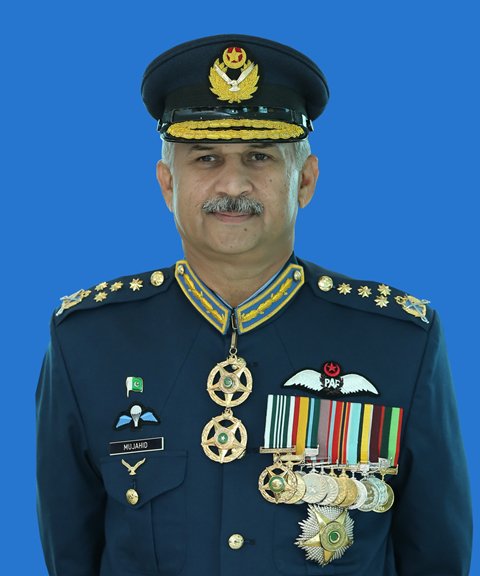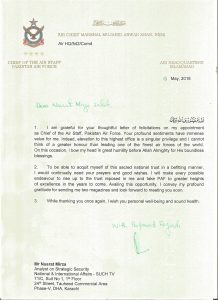Quaid-e-Azam Muhammad Ali Jinnah PAF Station Risalpur on 13th April, 1948
It gives me great pleasure to pay my first visit to a unit of the Royal Pakistan Air Force. There is no doubt that any country without a strong Air Force is at the mercy of any aggressor. Pakistan must build up her Air Force as quickly as possible. It must be an efficient Air Force second to none and must take its right place with the Army and the Navy in securing Pakistan’s defence.
I am well aware of air developments in other countries and my Government is determined that the Royal Pakistan Air Force will not lee behind.
Introduction
The Present Chief of the Air Staff,
Mujahid Anwar Khan
Nishan-i-Imtiaz (Military)
Air Chief Mujahid Anwar Khan Pakistan’s 22nd Chief of PAF 19 Mar 2018 – Till Date
Air Chief Marshal Mujahid Anwar Khan was commissioned in GD (P) Branch of Pakistan Air Force in December, 1983, and is the recipient of coveted Sword of Honour, Best Pilot Trophy and Chairman Joint Chiefs of Staff Committee Gold Medal from PAF Academy Asghar Khan. During his tenure of service, he has held various Command and Staff appointments including Command of a Fighter Squadron, a Tactical Attack Wing, Base Commander of two elite F-16 Bases and Air Officer Commanding of Regional Air Command. He is a qualified Flying Instructor and graduate of Combat Commanders’ School, Command and Staff College, Jordan; Air War College, Faisal and National Defence University, Islamabad. He has also served as Personal Staff Officer to Chief of the Air Staff, Assistant Chief of the Air Staff (Operations), Deputy Chief of the Air Staff (Operations), Director General C4I, Deputy Chief of the Air Staff (Support) and Director General Air Force Strategic Command at Air Headquarters, Islamabad. The Air Chief has flown various training and fighter aircraft including F-16, F-6, FT-5, T-37 and MFI-17. In recognition of his meritorious services, he has been awarded Nishan-i-Imtiaz (Military), Hilal-i-Imtiaz (Military), Sitara-i-Imtiaz (Military) and Tamgha-i-Imtiaz (Military)
Air strike is an important part of the military action. In modern war fare air force is the back bone of the military strength. Air force protect the ground forces from air and destroyed the enemies before they attack. Air force can fight the war against enemies where ground forces can not approach.
A Proud History
Pakistan Air Force was born on 14th of August 1947, with the independence of Pakistan. The growth of PAF is a story of unusual sacrifice. A tiny auxiliary Service, with a small number of personnel and insignificant equipment, emerging as a powerful weapon of the country’s defence, was a thrilling phenomenon. The dedication of its pioneers shaped the future of a force, destined to gain respect, after proving its worth in the wars of 1965 and 1971, where it was unfortunately vanquished by a much more powerful enemy, India. The story of PAF is a tale of development, despite heavy odds and limitations.
Every Man A Tiger
Pakistan Air Force is one of the best Air Force in the world. Pilots are well trained, well trained technician and supporting persons. We sleep well as they are always awaken.
The Pakistan Air Force is the aerial warfare branch of the Pakistan Armed Forces, tasked primarily with the aerial defence of Pakistan, with a secondary role of providing air support to the Pakistan Army and the Pakistan Navy.
INDUCTION IN PAKISTAN AIR FORCE
This is an era of revolutions in the scientific world. The war has advanced from one-to-one fighting to nuclear and Inter-continental missile system and remote control weapons, with minimum reaction time.
As Pakistan has strengthened its Army and Navy; it has also provided its Air force with latest aircraft like A-5, F-7, Mirage, F-16 and JF-17. Moreover continuous efforts are being made for the procurement of the latest aircraft. The aim is not only to make use of the latest military technology but to formulate an effective war strategy. The objective is also to train technical manpower, which is capable enough to exploit full potential of the available technology.
Quality is the hallmark of Pakistan Air Force. The selection system of PAF is designed to be lengthy & tough, as a result only capable individuals can be inducted. In order to maintain its traditions of professional excellence, the PAF is quite selective in choosing the right type of young men to maintain and support its sophisticated aircraft and equipment. Those who are selected and successfully complete PAF exhaustive and strenuous training can look forward to a rewarding, noble and honorable career. PAF offers a wide variety of these careers to the citizens of Pakistan. Life in the PAF is undoubtedly disciplined and demanding but then there are many rewards like handsome salary, accommodation, free medical facilities for self and family, generous leave and Air/Rail passage at concessional rates.
Moreover, the Air Force environment is delightful because one is always in the company of cheerful, energetic and dedicated men who are ready to do their best for each other. This privilege can only be appreciated by those who serve in this elite force.
Pakistan Air Force Bases
For the time being it appears that the credibility of Pakistan’s nuclear deterrent depends not on its limited-range missiles, but on the survivability of its strike aircraft. In peacetime the bulk of Pakistan’s combat aircraft are concentraed in seven air bases. However, there are roughly 30 airfields at which Pakistani nuclear-equiped aircraft could be based, vastly complicating Indian counterforce attack planning.
Major Operational Bases are fully functional bases from which aircraft operate during peacetime.
Forward Operational Bases are active during peacetime and become fully operational during wartime.
Satellite Bases are used for emergency landing and recovery of aircraft during both peacetime and wartime.
In addition there some two dozen other civilian airfields in Pakistan that could be used for landing and recovery of military aircraft during both peace and war. While some are full-fledged civilian airports, others consist of little more than a single runway and modest support facilities. Most are can be used by jet-fighter aircraft, and all can handle medium-sized tactical transports.



